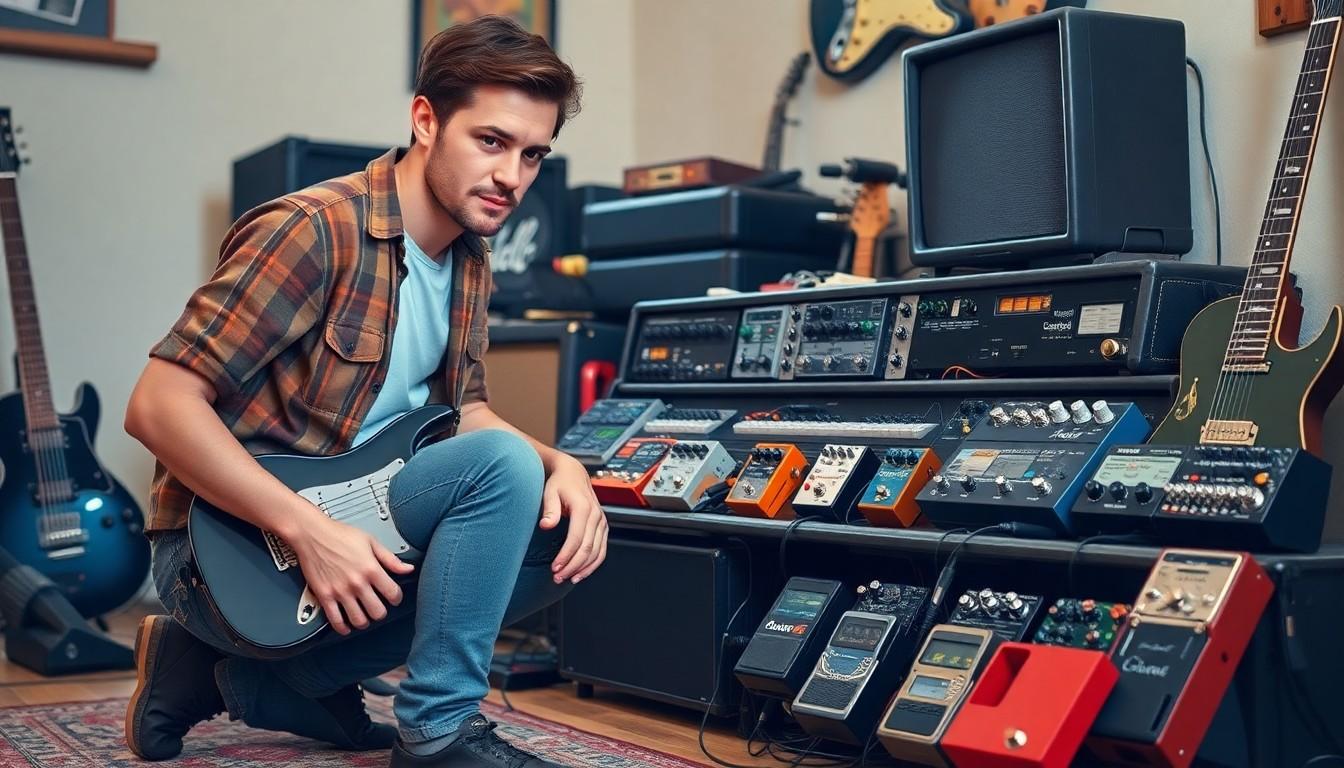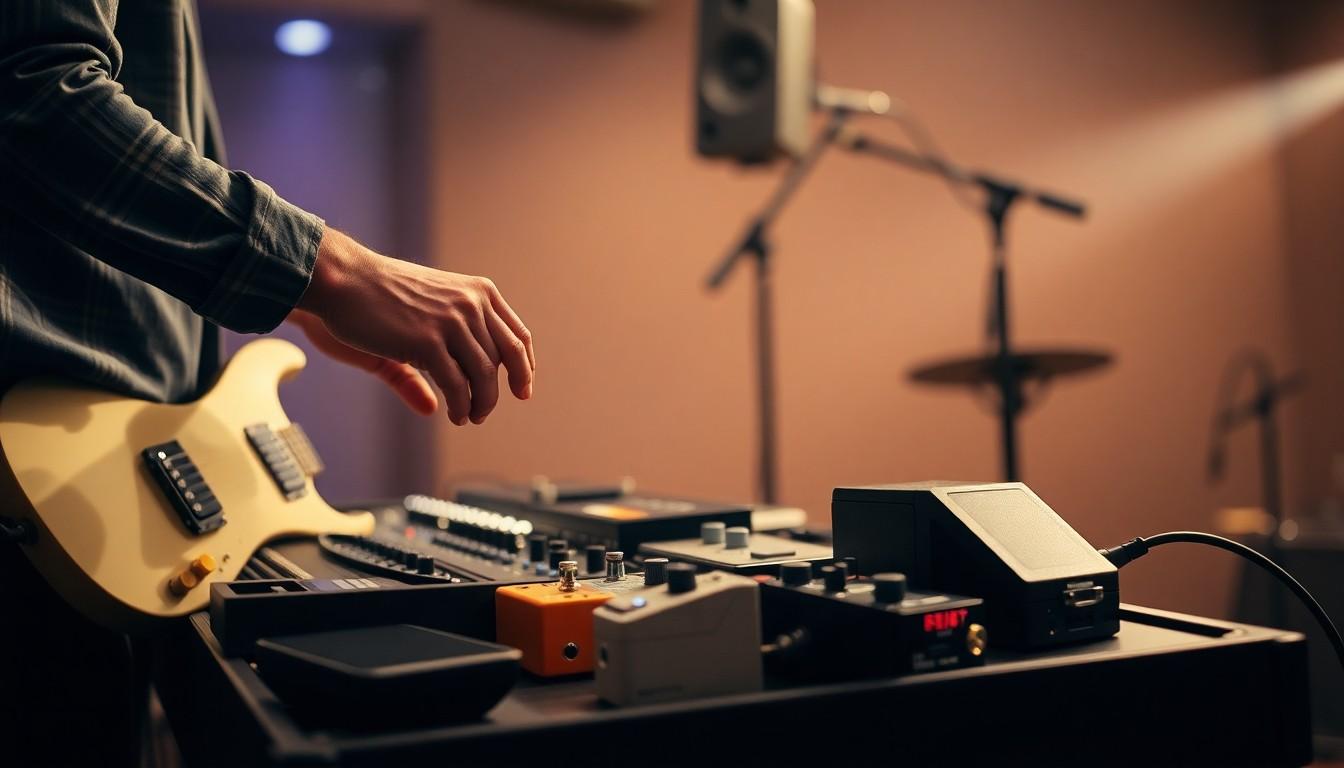
Setting up a pedalboard can feel like solving a musical puzzle. With countless pedals to choose from, figuring out the right order is key to unlocking your unique sound. It’s not just about aesthetics—it’s the foundation that shapes every riff and solo.
Imagine seamlessly blending crunchy overdrives with smooth delays, all without a hitch. A well-organized pedalboard boosts your creativity and keeps your gear in harmony. Whether you’re a seasoned pro or just starting out, mastering pedalboard order can transform your performance and elevate your tone to new heights.
Pedalboard Order
Pedalboard order determines signal flow, impacting tone and performance. Typically, pedals follow a sequence based on their function:
- Tuner Pedals
Ensure accurate pitch before processing signals.
- Dynamics Pedals
Control volume and compression to manage signal strength.
- Gain Pedals
Shape harmonic content with overdrive, distortion, or fuzz effects.
- Modulation Pedals
Add movement via chorus, delay, phaser, or flanger effects.
- Time-Based Pedals
Incorporate delay and reverb to create space and depth in sound.
Arranging pedals in this order maintains signal integrity and optimizes sound quality. For example, placing a distortion pedal before a delay ensures that the repeated signals maintain the intended distortion characteristics. Conversely, positioning modulation effects before gain can result in unwanted noise or diminished effect clarity.
Variations exist based on specific gear and desired outcomes. Some setups integrate multi-effects units, altering the traditional order for efficiency. Understanding each pedal’s role allows musicians to experiment and customize their setups effectively.
Common Pedal Order Configurations

Understanding common pedal order configurations helps musicians optimize their setups for desired sounds and performance efficiency.
The Standard Setup
The standard pedalboard arrangement begins with the tuner, ensuring accurate pitch before processing. Next, dynamics pedals like compressors control volume and sustain. Gain-based pedals, including overdrives and distortions, follow to shape harmonic content. Modulation effects such as chorus and phasers are placed thereafter, adding movement to the signal. Time-based pedals like delay and reverb conclude the chain, creating space and depth in the sound. This sequence maintains signal integrity and clarity, allowing each effect to function optimally. Musicians prefer this order for its reliability and proven effectiveness in various genres. Additionally, placements within this setup facilitate easy troubleshooting and adjustments during performances.
The Modulated Setup
The modulated setup prioritizes flexibility and experimentation with effect interactions. Starting with the tuner ensures pitch accuracy, similar to the standard setup. Dynamics pedals remain next, managing volume and sustain effectively. However, gain-based pedals are positioned after modulation effects like chorus or flanger, allowing modulation to influence the distorted signal uniquely. Time-based pedals follow, adding layers of space and ambiance. This configuration enables distinctive textures and nuanced soundscapes, favored by artists seeking innovative tones. By rearranging modulation before gain, musicians achieve unconventional sound dynamics and richer harmonic content. This setup supports creative exploration while maintaining essential signal control and clarity.
Factors Influencing Pedalboard Order
Several elements determine the optimal arrangement of pedals on a pedalboard. Understanding these factors ensures maximum performance and sound quality.
Signal Chain Considerations
The signal chain dictates how effects interact with each other. Placing pedals in the correct sequence preserves signal integrity and tonal clarity. Typically, the chain starts with dynamic pedals like compressors and tuners, ensuring a clean signal. Gain-based effects follow to shape distortion and overdrive. Modulation effects such as chorus and delay come next, adding depth without muddling the core tone. Finally, time-based pedals like reverb create ambient spaces. This order minimizes noise and prevents unwanted signal degradation. Additionally, power supply placement affects performance; isolating power for sensitive pedals can reduce interference. Proper signal chain arrangement enhances each pedal’s functionality, allowing musicians to achieve their desired sound effortlessly.
Frequency and Dynamics
Managing frequency and dynamics is crucial for a balanced tone. High-frequency pedals, such as EQs, should be positioned early in the chain to shape the signal before it reaches other effects. This placement allows for precise tone adjustments without being overshadowed by subsequent pedals. Dynamic control pedals, including compressors and volume pedals, regulate signal strength and ensure consistent output levels. By managing dynamics early, these pedals prevent clipping and maintain clarity throughout the signal path. Additionally, balancing low and high frequencies ensures that effects do not mask each other. Proper frequency and dynamics management results in a cohesive and versatile sound, enabling musicians to explore a wide range of tonal possibilities without compromising quality.
Optimizing Your Pedalboard Layout
A well-organized pedalboard maximizes efficiency and enhances performance. Proper arrangement ensures each pedal functions correctly within the signal chain.
Space Management
Efficient space utilization on the pedalboard prevents clutter and facilitates easy access to each effect. Musicians arrange pedals horizontally, aligning similar types together for quick adjustments during performances. Compact pedalboards accommodate up to twelve units, maintaining essential effects without overcrowding. Frequently used pedals position at the top, simplifying toggling during gigs. Multi-level racks optimize space, allowing additional pedals without expanding the board’s footprint. Cable management solutions, such as Velcro ties, ensure a tidy setup, reducing signal interference and enhancing reliability. Customizable layouts enable musicians to adapt their pedalboard as their needs evolve, ensuring a streamlined and functional arrangement that supports dynamic performances.
Power Supply and Connectivity
Reliable power sources maintain pedal performance and signal integrity. Dedicated power supplies provide consistent voltage to each pedal, minimizing noise and preventing disruptions. A typical pedalboard setup uses isolated power adapters with multiple outputs to accommodate various pedal requirements. Daisy-chaining efficiently connects pedals, reducing the number of power cables needed. High-quality cables ensure stable connections, preserving tone and responsiveness. Modular connectivity options, such as patch bays or switchers, allow easy reconfiguration of the signal chain, enhancing versatility and control. Investing in a robust power solution guarantees each pedal receives adequate power, ensuring optimal performance during rehearsals and live shows.
A well-ordered pedalboard is essential for any musician seeking to craft their unique sound. By carefully arranging pedals to manage signal flow and maintain tone integrity, musicians can enhance both creativity and performance.
Optimizing pedal placement ensures that each effect contributes harmoniously to the overall sound. Whether sticking to the standard setup or experimenting with alternative configurations, flexibility and clarity remain key.
Investing time in organizing the pedalboard not only streamlines performances but also empowers musicians to explore new sonic landscapes with confidence and precision.


